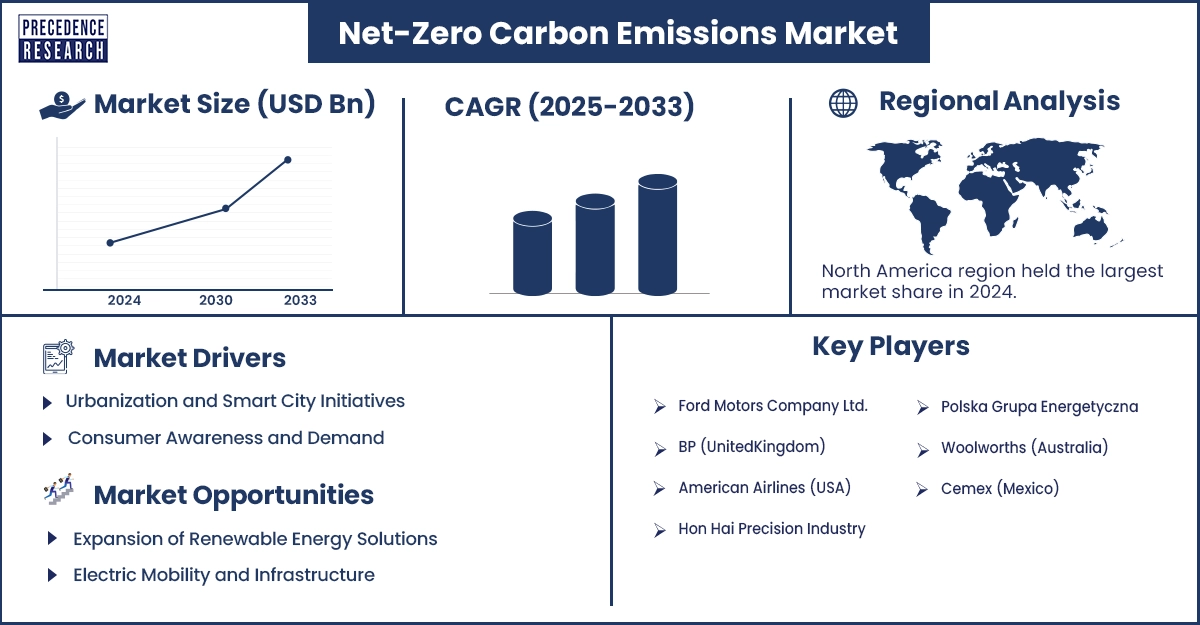Net-Zero Carbon Emissions Market Revenue and Forecast by 2033
Net-Zero Carbon Emissions Market Revenue and Trends 2025 to 2033
The net-zero carbon emissions market is projected to grow steadily from 2025 to 2033, driven by clean energy adoption, regulatory mandates, and ESG initiatives. The growth of the market is driven by stringent emission reduction targets set by governments around the world.

Market Overview
The worldwide net-zero carbon emissions market is growing at a significant rate, driven by stringent regulations imposed by regulatory bodies to reduce carbon emissions. It encompasses various mechanisms, including renewable projects and advanced technologies, that help control emissions. With the increased awareness of climate change impacts, various industries have set their carbon emission targets. In addition, governments’ net-zero emission initiatives further boost the growth of the market.
Governments around the world are encouraging economies to decarbonize through net-zero targets. Through novel technologies, such as carbon offsetting and carbon capture technologies, it is possible to achieve net-zero carbon emission targets. In addition, rapid transition to renewable energy sources contributes to market expansion. Several countries are setting ambitious targets to reduce carbon emissions. For instance, recently, several economies including the U.S., Canada, the UK, and EU countries have released comprehensive net-zero roadmaps to become carbon neutral by the middle of the century.
Highlights of the Net-Zero Carbon Emissions Market
Type Insights
The transportation sector dominated the market in 2024. The transportation sector is a major contributor to carbon emissions, creating an urgent need for decarbonization. The emergence of electric vehicles has paved the way for the decarbonization of the transportation sector. Improvements in battery technology are making electric vehicles more efficient, reducing carbon emissions. The rising government funding for boosting the development and adoption of electric vehicles further bolsters the growth of the segment.
On the other hand, the agriculture sector is likely to witness significant growth during the forecast period. The growth of the segment can be attributed to the rising adoption of sustainable agriculture practices. Governments are also offering financial incentives for sustainable farming practices.
Key Trends in the Net-Zero Carbon Emissions Market
Growing Awareness of Sustainability
The growing awareness regarding environmental sustainability is encouraging countries to set their net-zero goals. As of now, over 140 countries worldwide have set their net-zero emission targets. To achieve these targets, several countries are rapidly promoting renewable energy sources. Renewable energy sources like solar and wind lower emissions, which are beneficial in achieving carbon reduction targets.
Corporate Social Responsibility
Several companies are setting ambitious targets for minimizing their carbon footprint. They are also focusing on sustainable practices to stand out in the market. Companies that demonstrate a commitment to sustainability can enhance their brand reputation. Leading brands are integrating net-zero ambitions into brand storytelling, investing in real-time carbon tracking.
Technological Advancements
Technological advancements create immense opportunities in the market. Advancements in technology led to the development of carbon capture and storage technologies. These technologies capture carbon emissions and store them for use in other processes. Digital platforms, artificial intelligence technologies, carbon credit trading platforms, and blockchain-based carbon credit solutions offer transparency and accountability for emissions reduction initiatives.
Regional Insights
North America dominated the net-zero carbon emissions market with a considerable share in 2024 and is expected to witness steady growth in the coming years. North America has been at the forefront of technological innovation, leading to the rapid development of carbon capture and storage solutions. There is a high adoption of renewable energy sources. The U.S. and Canadian governments have imposed stringent regulations regarding environmental sustainability, encouraging businesses to invest in renewable energy and green infrastructure.
Asia Pacific is expected to witness rapid growth in the market during the forecast period. With rapid industrialization, there is an increased concern regarding pollution. Thus, governments around the region have imposed stringent regulations on various industries to reduce carbon emissions. Governments of various countries have set their carbon neutrality targets. This, in turn, boosts the demand for carbon offsetting and carbon capture, utilization, and storage solutions. The region market is also benefiting from the ambitious carbon neutral targets of China, India, Japan, and South Korea. These countries are investing heavily in clean energy programs to achieve decarbonizing industrial processes.
Europe is one of the major contributors to the market. Europe has become the world’s frontrunner in maintaining clean air. The European Union’s Green Deal project is pushing industries across the region toward decarbonization. As a result, there is a high adoption of renewable energy technologies in Germany and France. Governments and businesses around the region are investing in clean energy infrastructure in order to offset fossil fuel dependence and achieve carbon neutrality goals.
Recent Developments
- In October 2024, Carbon Clean announced the launch of its breakthrough CycloneCC C1 series, marking the penultimate stage in technology’s commercialization. The CycloneCC C1 series is available in concentrations ranging from 3% to 20%, capturing up to 100,000 tons of CO2 per year.
- In June 2023, Technip Energies introduced Canopy by T.EN, an integrated suite of flexible and modular post-combustion carbon capture solutions, powered by Shell CANSOLV CO2 Capture System.
- In August 2022, IndianOil announced a plan to achieve net-zero operational emissions by 2046.
Net-Zero Carbon Emissions Market Key Players
- Ford Motors Company Ltd. (USA)
- BP (UnitedKingdom)
- American Airlines (USA)
- Hon Hai Precision Industry (Taiwan)
- Polska Grupa Energetyczna (Poland)
- Woolworths (Australia)
- Cemex (Mexico)
Segments Covered in the Report
By Type
- Transportation Facilities
- Agricultural Practices
- Industrial Sector
Get this report to explore global market size, share, CAGR, and trends, featuring detailed segmental analysis and an insightful competitive landscape
overview @https://www.precedenceresearch.com/sample/2471
You can place an order or ask any questions, please feel free to contact at sales@precedenceresearch.com |+1 804 441 9344